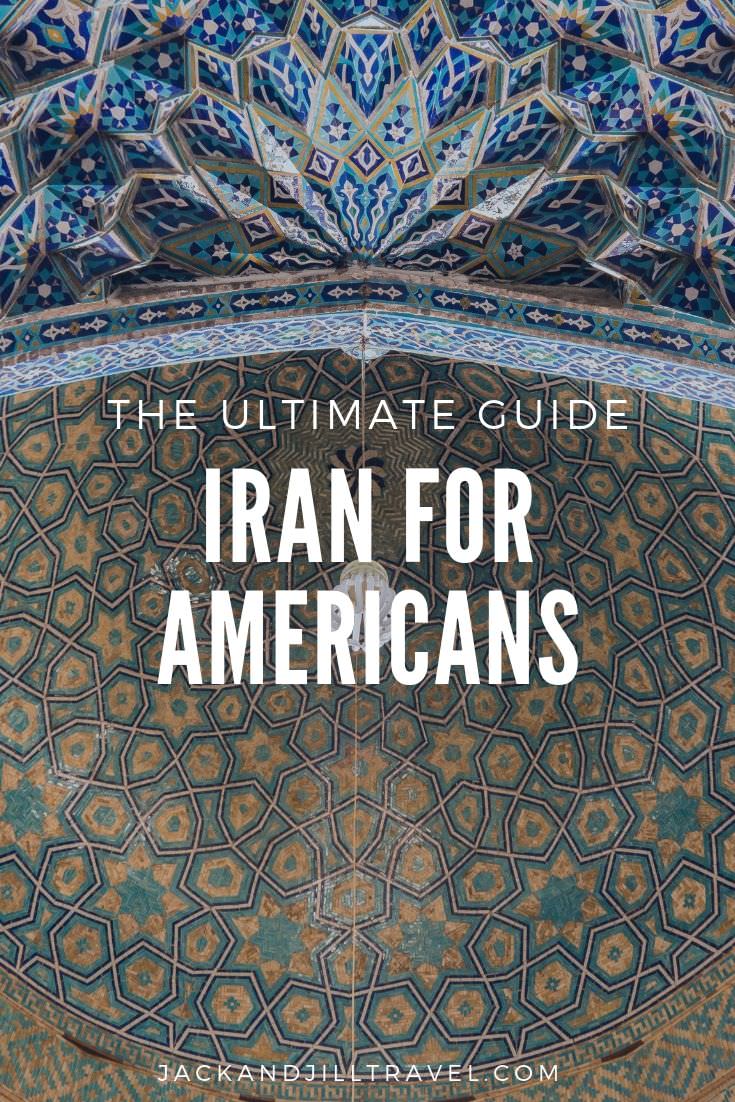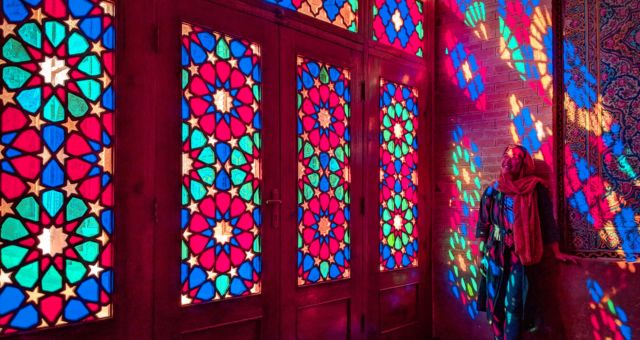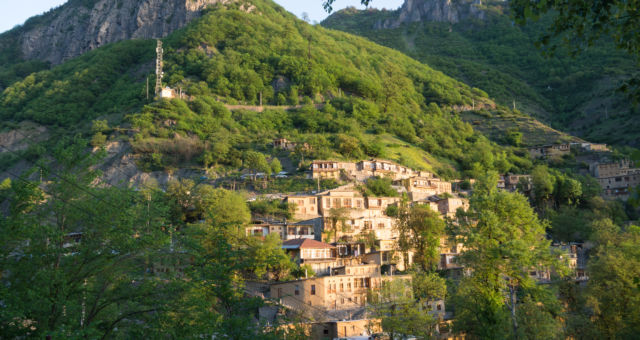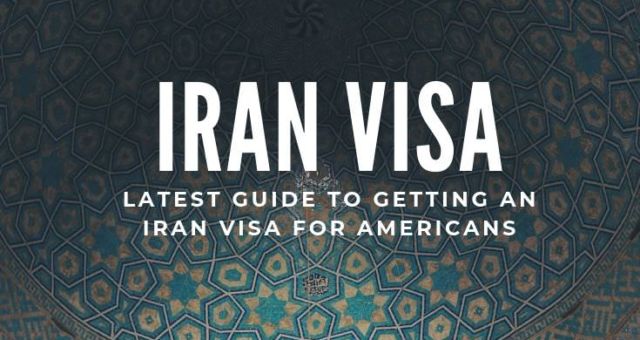I just came back from Iran and I’m still digesting everything I saw and experienced. What a country! So much history, so many beautiful monuments (and you know me, nature being my jam, I don’t usually do museums or monuments). Iran was my first Middle East country I’ve visited and I think I made the right choice in picking Iran as my introduction to the region. Because of my US citizenship, I had to go with a guide – which is not usually my style – but having a guide and a car made the trip very smooth and hassle-free.
On this post, you will find all the necessary information for traveling to Iran as a US citizen. You’ll also find my thoughts on safety issue, traveling to Iran as a vegetarian, and other brain-dump type of commentaries.
But first, let’s get something out of the way…
Pink mosque in Shiraz
Can Americans Travel to Iran?
Yes, Americans can legally travel to Iran, with the following restrictions:
- Americans will not be eligible for visa-on-arrival, so you’ll need to get your Iran visa before your trip. The process takes 2-3 months.
- Americans (as well as UK and Canada citizens) must apply for their visa through an Iranian travel agency. No exception.
- Americans are also required to be accompanied with a guide with a pre-determined itinerary.
This means that you must travel following a fixed itinerary and you’re not allowed to deviate from it. No spontaneous change of plan, no accepting invitations to people’s houses. You will have to be accompanied by a licensed guide throughout the duration of your stay in Iran. Technically this means that your guide is supposed to be with you the second you step out of your hotel.
As someone who thrives on solo travel, personal time alone, and unstructured free time, I worried that I’d find this constrictive. Thankfully I had a great guide that was willing to be flexible and I do have some experience traveling with randos off the Internet.
You can try finding a licensed guide through online forum or referral (ask me!), but going through a travel agency will make most sense for first time visitors to Iran. There’s no need to join a group tour though, instead you could go on a private, custom trip based on your interests and schedule. Surprisingly, it’s not that much more expensive than a group tour.
Isfahan.
Iran Visa for Americans
Step 1. Find a reputable travel agency
Step 2. Work out your Iran itinerary
Step 3. Submit requested documentation to the travel agency. At this step, you also need to specify where you’re going to pick up your visa. For me this was the Iranian interest in Pakistani Embassy in Washington DC.
Step 4. After 2-3 months, if approved you will receive a Visa Grant Code (also called authorization code).
Step 5. Mail your Visa Grant Code + visa fee + passport to your pre-determined pick up point.
Step 6. Pick up/receive your passport with an attached Iran visa.
How to Guide: Iran Visa for Americans
Safety
Is it Safe to Visit Iran?
Safety is such a tricky question I almost never talk about it. Safety is subjective (is it real or perceived risk?), anecdotal (just because nothing happens to you, it doesn’t mean it’s safe), and contextual (like when a 6’4″ tall, 200lbs man claims a country is “safe”).
But safety is the first thing that comes to mind to a lot of people when the subject of travel to Iran comes up, so I feel that I have to mention it here. So how safe is Iran? Should Americans travel in Iran?
Petty Crimes in Iran
I felt safer walking the streets in Iran than I do back home here in San Francisco. While in Iran, I didn’t feel like someone would snatch the phone off my hand while I’m walking down the street. I never felt like I had to constantly keep an eye on my belonging in public (I still do, because it’s a smart thing to do).
Generally speaking, nobody in Iran is out to scam you. No tea house invitations, no friendship bracelets, or such non-sense. My time in Iran was hassle-free. It was so nice not to have to be on my guard all the time.
Rooftop meander in Kashan
Female Safety in Iran
As a female, I found it refreshing not to get ogled or cat-called. Instead I was treated with deference by every male I interacted with even when I was by myself. I can’t speak for what it’s like to be a solo woman traveler in Iran dealing with public transportation and such. However from my research, solo women travelers find Iran to be one of the safest countries to travel (as in anywhere else, common sense prevails).
But it doesn’t mean that my trip in Iran was worry-free. As an American, I did have some safety concern.
Is Iran safe for Americans?
When I was traveling in Iran, the rhetoric against Iran by the Trump administration was at its peak. The US aircraft carriers were on their way to the Gulf. There was even talk about sending troops. In response, Iranian government increased their anti-American, anti-Israel counter-rhetoric back.
If war broke out, selfishly I wondered how it would affect me, especially on my ability to leave. My biggest Iran safety concerns was our governments’ hostility towards each other, but never the Iranian people themselves.
Because of that, I never felt that I had to hide my nationality. When people ask, and they do ask, where I’m from, I don’t hesitate to say “the US” or “America”. We often bonded immediately over our shared frustration at the current situation and the feelings that our respective governments don’t represent our best interest.
Iranians are very aware of how they’re being being portrayed in the West – an Iranian I met literally said “Please tell your friends we are not terrorists” – they go out of their way to prove just the opposite. Among avid travelers, the hospitality of Iranian people are widely known.
Warm smiles and colors of Iran.
Best Time to Travel to Iran
Most first time travelers to Iran will follow the “classic route” which includes the cities of Tehran, Isfahan, Yazd, and Shiraz. For this classic Iran itinerary, Spring time (March – May) and Fall (September – October) would be the best time to travel to Iran since temperature will be milder. I was warned that desert cities such as Yazd gets searing hot during summer (> 40C). As a woman in Iran, having to cover up, I can’t imagine it would be comfortable at all.
Traveling in Iran during Ramadan
Purely by coincidence, I found myself traveling in Iran during Ramadan (which in 2019 fell on May). Ramadan is not the most ideal time to travel in Iran. Most shops and restaurants are closed during the day. Bazaars and the streets are quieter because of it. Monuments and museums do stay open, however.
Evenings is your prime people watching time during Ramadan in Iran. Shops and restaurants shift their opening hour to around 4-5pm, a few hours before iftar (end of fast). Our strategy was to get our sightseeing done early and afterwards, we were able to enjoy lively iftar atmosphere in public squares and bazaars.
Lunch time during Ramadan can be tricky. Only restaurants with special permit are allowed to be open during the day in Ramadan and finding these restaurants is not easy even with an experienced guide. A restaurant that was open last year isn’t necessarily going to get a permit this year. Not to mention that for sensitivity reason, these restaurants do not look open from the outside.
Drinking and eating in public during Ramadan is discouraged. So if you find yourself traveling in Iran during Ramadan, just be discreet if you need to take sip of water or snack in public.
So yeah, it wasn’t ideal since I do love to snack and check out the street food scene when traveling. As a matter of fact, I lost weight during this trip. First since Tibet!
What to Wear in Iran
Women
I feel that being a tourist in Iran gets you a lot of leeway in terms of clothing. As long as you make an effort, I wouldn’t stress too much about it. Also, as a woman, you will adjust your head cover about 10 million times a day. You’ve been warned.
I bought the green/blue manteau in Iran ($8) and the yellow scarf ($3). Plus a sleeveless top underneath, and thin legging from Uniqlo.
You will need to cover your hair as soon as you land in Iran, so make sure that you have a scarf in your carry-on bag. Arms, legs, cleavage, and hair should be covered. 3/4 sleeves seem to be acceptable. One of your layers will need to be long enough to cover your butt. For traveling in warmer months, I’d go for long light-weight, loose tunics such a this.
I spent more time than than usual figuring out what to bring to Iran but in the end none of the stuff I brought with me worked out. The 3 scarfs I brought were either too slippery or too thick. My cardigans, suitable for San Francisco mild summer temperature, were too warm for springtime in Iran. I ended up buying pretty much a whole new ayatollah-approved wardrobe in Iran such as scarfs, long shirts, and a light-weight manteau.
Visiting Iran in spring/summer? My recommendation is to get a light-weight manteau as soon as you arrive in Iran. Then you can wear any tops you want underneath. I paired the manteau with a pair of thin leggings from Uniqlo. I wore that combo most days in Iran.
Make up, jewelry, tight jeans/leggings, and wearing sandals is also completely acceptable in Iran. The latter was the only salvation on warmer days.
Men
Men can get by with regular clothes with the exception for shorts, muscle shirts, and sleeve-less shirts.
Food and Drink
You can drink the tap water
Tap water is drinkable in most cities in Iran and you’ll see plenty of water fountains in public areas all throughout Iran. Double check with your guide or your hotel. Bottled water is very cheap, but bringing a water bottle with built-in filter (like this) means less plastic and less waste.
No alcohol
You won’t find alcohol sold anywhere in Iran (at least not publicly). Learn to embrace it by ordering one of the many creative mocktails and colorful herbal drinks.
Being a Vegetarian in Iran
Not to sugarcoat it, but being a vegetarian in Iran wasn’t easy. I do hope you love eggplant because you’ll be eating a lot of it. In restaurants, your best bet would be to look for Kashk-e Bademjan (often listed on the menu as “eggplant with whey”), a vegetarian dish made of eggplants, herbs, and yoghurt. There’s also Mirza Ghasemi made with eggplants, tomato, and eggs. Less often seen is Kookoo Sabzi, some type of crust-less quiche made of spinach and egg.
Restaurants in touristy places might serve vegetarian version of some of Iran’s popular traditional dishes such as fesenjan, a pomegranate-walnut stew, but this was an exception rather than the rule.
There are plenty of fast food restaurants selling falafels and samosas (and also spaghetti?). These are handy for quick snacks or when you’re tired of eating eggplant.
What if you’re vegan? Oh man, it’s going to be so tough. You might want to bring your own food?
Day 4 in Iran, I begged my guide at a restaurant “Anything but eggplant, pleaaaase!” He talked to the restaurant owner and he agreed to make me something off menu. Not sure what this is, but it was delicious (and more importantly, not eggplant!)
Left: Zulbiya (fried dough soaked in syrup). Right: A mocktail – no alcohol, no problem. Get one of these colorful, delicious mocktails in one of the many Iranian cafes.
Home Cooked Food
I feel that Iran is one of those countries where the best food come from homes and not restaurants. I think many would agree? Try to include a cooking class or a dinner with a local family in your itinerary.
Desert
If you have sweet tooth, you’re in luck. Iran has a lot of different types of sweets and desert, many are region-specific. They often incorporate rose water, saffron, and pistachios. Some regional Iranian sweets you have to try are:
- Koluche/Kolooche, a type of bready cookie stuffed with a mix of cinnamon and sugar. The best known kolooche comes from the city of Fuman, where we stopped on our way to Masouleh.
- Gaz, Iranian nougat from Yazd
- Zulbiya & Bamiye – fried dough drenched in syrup, popular during Ramadan.
- Sohan from Qom. A type of brittle toffee made of saffron, cardamom, and rose butter. And butter. Tons of butter.
- Shiraz-faloudeh from Shiraz. A starch-based noodle served with ice cream, rose syrup, and optional lemon juice.
Pink lake near Shiraz
Money Matter
Bring Cash
Bring all the cash you think you’ll need. You can’t use debit or credit cards in Iran, and ATMs will not work. Iran has its own banking system, separate from any global financial network such as Visa or Mastercard.
How much money do you need to bring?
Your tour price will at least include hotel and transportation. It might or might not include entrance fee. On top of the tour, I spent 120 USD for the 12 days I was Iran paying for my own food, entrance fees, and other incidentals (SIM card, souvenirs, etc). Because of the weak exchange rate (especially with the sanctions), your dollar or euro will go far.
If you come to Iran wanting to buy a Persian carpet (that can cost up to thousands of dollars), don’t feel the need to bring a duffel bag of cash with you. Bigger stores will actually accept Visa/Mastercard. Some will charge a percentage for the convenience but you can find some that don’t. Having said that, cash is king and you’ll have a better bargaining power when paying with cash.
Iran Tourist Card
This is a type of reloadable debit card that’s very convenient since it’s accepted pretty much everywhere in Iran. Everybody in Iran uses some type of debit card for payment. So when using cash, be prepared to get panic looks whenever a shop owner realises he can’t give you change.
Ask your travel agency to help set up a prepaid debit card for you or get it yourself at MahCard (they deliver to your accommodation, set up fee 20 Euros). I also heard that you can get an Iran debit card at the Melli Bank branch at Imam Khomeini International Airport.
Currency Exchange Rate
Keep in mind that the “official” exchange rate, the kind you’ll see on Xe.com is not what you’ll get in Iran. The black market or the free market rate can be 3x more that. Check current market rate here. In most other countries, changing money in the non-official market means covert dealing in some quiet, dark alley. In Iran, however, any currency exchange office will be able to sell you Rials at the free market rate.
TLDR; Don’t exchange at the banks who will give you much lower rate. Go instead to one of the licensed exchange shops. In Tehran, these shops can be found on Ferdowsi Street around Ferdowsi Square.
Toman vs Rial
I’m not sure why exactly, but in Iran there are 2 different currencies commonly used: Rial and Toman.
“Iranian Rial” is the officialy currency of Iran. The bills and coins that in Iran are in Rials. However, prices all throughout the country are quoted in “Tomans” with 1 Toman = 10 Rials. For example, you’ll see a scarf with the price tag of 50.000. This is 50.000 Tomans. The actual price is 500.000 Rials and that’s how much you’ll need to pay in physical money.
It can be very confusing. In the first couple of days, I kept thinking everyone was short-changing me, but I quickly got used to it. I’m sure you will too.
While in Iran, always look up
Internet
I recently switched to Google Project Fi, Google’s pay as you go network (get $20 credit) that has coverage in over 170 countries. Of course Iran isn’t one of them. Ugh.
Local SIM Card
So while in Iran, I had to get a SIM card. It was easy to do and I highly recommend it – ask your travel agency to get you one. I used Irancell that has an English menu option and rechargeable cards can be bought at any newspaper stand. 15.000 Tomans (about $1) gets me 2GB of data. It’s so cheap that my travel partner used its cell data to stream Game of Throne episodes!
VPN
Many social media apps are blocked such as Facebook, Twitter, and Youtube. Random websites (some Wikipedia pages) are also blocked. VPN to the rescue! I use ExpressVPN myself, but just to be on the safe side, get different VPN providers before you arrive because some might work better than others.
PSA: I always use paid service from reputable VPN providers because there’s no such thing as a free lunch (how much is your personal data worth to you?)

Recommended Pre-Trip Reading
- Lipstick Jihad – a memoir by an Iranian-American. I read this for the first time in college, this book and my Iranian roommate was how Iran entered my consciousness for the first time.
- Iran Awakening: A Memoir of Revolution and Hope – this is the story of an Iranian female lawyer fighting the regime on behalf of Canadian journalist – Zara Kazemi. This book was a tough read because of the subject and it stayed with me for a long time.
- I, Who Did Not Die – a true story set in the little known, but extremely brutal Iran-Iraq war in 1980’s.
- The Gift: Poems by Hafiz, the Great Sufi Master – you can’t visit Iran and not hear about Hafez, a much-beloved Persian poet who hailed from Shiraz. Iranian children learn about Hafiz in school and his works can be found in almost every Iranian home.
—
Anything else you’d like to know about traveling to Iran as a US citizen? Let me know in the comments or get in touch with me. Looking for inspirations on where to visit in Iran? See this post. I also have a great recommendation for a guide who speaks excellent English and is licensed to take US, UK, and Canada citizens.





Questions and Comments
Comments are disabled. If you have any questions about the post, you can DM me on Instagram: @jacknjilltravel.